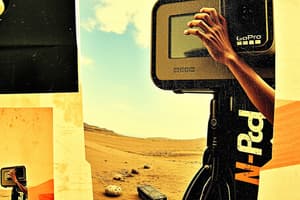Podcast
Questions and Answers
Which of the following statements accurately compares Solid State Drives (SSD) and Hard Disk Drives (HDD)?
Which of the following statements accurately compares Solid State Drives (SSD) and Hard Disk Drives (HDD)?
- SSD and HDD have similar speeds, prices, and lifespans.
- SSD is slower, more expensive, and has a shorter lifespan compared to HDD.
- SSD is faster, more expensive, and has a shorter lifespan compared to HDD. (correct)
- SSD is slower, less expensive and has a longer lifespan compared to HDD.
Interlaced video is generally better than progressive video for capturing moving objects due to its higher frame rate.
Interlaced video is generally better than progressive video for capturing moving objects due to its higher frame rate.
False (B)
Explain how a histogram is used in photography and what information it provides to photographers.
Explain how a histogram is used in photography and what information it provides to photographers.
A histogram is a graph showing the brightness distribution of a picture. It helps photographers adjust exposure by displaying the darkest and brightest areas.
In the context of camera lenses, the 'EF' designation refers to the ______.
In the context of camera lenses, the 'EF' designation refers to the ______.
Match the following shot scales with their descriptions:
Match the following shot scales with their descriptions:
What is the purpose of barn doors in the context of lighting?
What is the purpose of barn doors in the context of lighting?
Which of the following best describes the relationship between aperture (f-stop) and depth of field (DoF)?
Which of the following best describes the relationship between aperture (f-stop) and depth of field (DoF)?
What is the primary advantage of using a lavalier microphone?
What is the primary advantage of using a lavalier microphone?
Which of the following statements best describes the primary function of the Program Control Room (PCR) in a studio production?
Which of the following statements best describes the primary function of the Program Control Room (PCR) in a studio production?
A trickster mixer allows you to record, broadcast, and stream simultaneously.
A trickster mixer allows you to record, broadcast, and stream simultaneously.
What unit of measurement is used to define white balance?
What unit of measurement is used to define white balance?
A _______________ is used to create the illusion of an unlimited space.
A _______________ is used to create the illusion of an unlimited space.
What is the main difference between zooming and dollying a camera?
What is the main difference between zooming and dollying a camera?
Match the connector type with its primary usage:
Match the connector type with its primary usage:
A photo of an airplane displayed on PowerPoint appears blurry. What is the most likely cause of this?
A photo of an airplane displayed on PowerPoint appears blurry. What is the most likely cause of this?
In the context of 3-point lighting, what is the primary purpose of the fill light?
In the context of 3-point lighting, what is the primary purpose of the fill light?
Why is it important to ensure that audio levels do not peak at 0dB on an audio mixer?
Why is it important to ensure that audio levels do not peak at 0dB on an audio mixer?
Using a high key lighting setup is characterized by dark, moody atmospheres and strong shadows.
Using a high key lighting setup is characterized by dark, moody atmospheres and strong shadows.
What is the main purpose of a backlight in a three-point lighting setup?
What is the main purpose of a backlight in a three-point lighting setup?
The primary light source in a three-point lighting setup is known as the ______.
The primary light source in a three-point lighting setup is known as the ______.
Match the following descriptions with the appropriate component of a studio camera system:
Match the following descriptions with the appropriate component of a studio camera system:
What is the primary purpose of using bounce cards in a lighting setup?
What is the primary purpose of using bounce cards in a lighting setup?
When working with a tripod, what is best practice before making any movements with the camera?
When working with a tripod, what is best practice before making any movements with the camera?
Which video file format is recommended for high-quality compressed video?
Which video file format is recommended for high-quality compressed video?
In aperture priority mode (A/Av), what does the user directly control, and what does the camera automatically adjust?
In aperture priority mode (A/Av), what does the user directly control, and what does the camera automatically adjust?
A higher ISO setting (e.g., 800+) generally results in a cleaner image with less visible noise, making it ideal for daylight photography.
A higher ISO setting (e.g., 800+) generally results in a cleaner image with less visible noise, making it ideal for daylight photography.
List the three components of a three-point lighting setup and briefly describe the primary function of each.
List the three components of a three-point lighting setup and briefly describe the primary function of each.
A light modifier used to soften harsh light is called a ______.
A light modifier used to soften harsh light is called a ______.
Match each video compression term with its correct description.
Match each video compression term with its correct description.
Which of the following frame types in video compression stores only the changes from the previous frame, rather than the full image?
Which of the following frame types in video compression stores only the changes from the previous frame, rather than the full image?
When setting up for an ENG (Electronic News Gathering) interview, it is not essential to check the memory card space since most cameras have ample internal storage.
When setting up for an ENG (Electronic News Gathering) interview, it is not essential to check the memory card space since most cameras have ample internal storage.
Explain the difference between 'hard light' and 'soft light', detailing how each affects the appearance of shadows.
Explain the difference between 'hard light' and 'soft light', detailing how each affects the appearance of shadows.
Flashcards
HDR
HDR
High Dynamic Range. Captures a greater range of luminance than standard.
SSD
SSD
Faster, more expensive storage with shorter lifespan.
HDD
HDD
Slower, less expensive storage with longer lifespan.
Progressive Scan
Progressive Scan
Signup and view all the flashcards
Histogram
Histogram
Signup and view all the flashcards
Aperture (f-stop)
Aperture (f-stop)
Signup and view all the flashcards
Shutter Speed
Shutter Speed
Signup and view all the flashcards
Zoom Lens
Zoom Lens
Signup and view all the flashcards
PCR (Program Control Room)
PCR (Program Control Room)
Signup and view all the flashcards
CCU (Camera Control Unit)
CCU (Camera Control Unit)
Signup and view all the flashcards
Cyclorama (cyc)
Cyclorama (cyc)
Signup and view all the flashcards
Matte box
Matte box
Signup and view all the flashcards
Dolly
Dolly
Signup and view all the flashcards
Key light
Key light
Signup and view all the flashcards
Barn doors
Barn doors
Signup and view all the flashcards
Communication Panels
Communication Panels
Signup and view all the flashcards
Fill Light
Fill Light
Signup and view all the flashcards
Backlight
Backlight
Signup and view all the flashcards
White Balance (WB)
White Balance (WB)
Signup and view all the flashcards
Audio Mixer (AVID S2)
Audio Mixer (AVID S2)
Signup and view all the flashcards
H.264 / H.265 (HEVC)
H.264 / H.265 (HEVC)
Signup and view all the flashcards
MP4 (H.264)
MP4 (H.264)
Signup and view all the flashcards
Lens Mount
Lens Mount
Signup and view all the flashcards
Camera Sensor
Camera Sensor
Signup and view all the flashcards
Aperture Priority (A/Av)
Aperture Priority (A/Av)
Signup and view all the flashcards
Bounce Lighting
Bounce Lighting
Signup and view all the flashcards
Codec
Codec
Signup and view all the flashcards
Frame Rate (fps)
Frame Rate (fps)
Signup and view all the flashcards
Study Notes
- PCR stands for Program Control Room.
- Trickster mixer allows you to record, broadcast, and stream simultaneously.
- Transition bar controls the transition speed.
- Teleprompter tips include being 6 feet away from the subject and set at eye level.
- Jog control adjusts the speed and direction of text displayed on the teleprompter.
- CCU controls white balance, black balance, and aperture.
- ENG stands for Electric News Gathering.
- Cyclorama is a green screen used to create an illusion of unlimited space.
- Fluid head friction gives smoother movement.
- Teleprompters help talent deliver speeches without memorizing.
- Matte shield boxes avoid light entering, which helps the talent read the teleprompter properly.
- Lens donut is a camera accessory that blocks light from entering the teleprompter and matte box.
- ISO refers to sensor sensitivity to light.
- Aperture is the size of the lens opening.
- Shutter speed is the amount of time the sensor/film is exposed to light.
- Zoom changes the focal length without physical movement.
- Dolly involves the physical movement of the camera.
- On a zoom handle, F stands for faster, and S stands for slow.
- Common camera movements include Dolly, Pan, Tilt, Roll, and Truck
- DMX is used for light control with 5 pin connectors.
- XLR cables with 3 pin connectors are used for audio control.
- Studio camera components include the camera body, viewfinder, lens, blue box, communication box, handle with zooming, tripod, teleprompter, and headphones.
- A histogram shows blackness on the left and brightness on the right.
- JPEG is a way to shrink photo file sizes.
- RAW captures all data from what a sensor can capture.
- Lossless compression maintains quality but results in bigger files sizes.
- Lossy compression reduces file sizes, but some quality is lost.
- Motion blur is when an image is condensed and provokes the quality.
- H.264 is the most common video codec.
- White balance is measured in Kelvin scale.
- Key light is the primary and most intense light in 3-point lighting.
- Fill light cancels shadows created by the key light.
- Back light shines from behind the subject.
- Barn doors direct or shape light.
- A Gel diffuser diffuses paper in light.
- Barn doors are used for studio lighting.
- Resolution is measured in pixels, while aspect ratio is width and height.
- Dynamic range is the difference between the darkest and brightest parts of an image.
- 4K resolution is 3840 x 2160.
- Full HD resolution is 1920 x 1080.
- 5K resolution is 5120 x 2880.
- 8K resolution is 7680 x 4320.
- HDR means High Dynamic Range.
- With HDD VR SDD, SDD is typically faster and more expensive, with a shorter lifespan, whereas HDD is slower and less expensive, with a longer lifespan.
- Interlaced scanning causes blurry moving objects.
- Progressive scanning creates clear moving object images.
- A histogram is a graph showing the brightness of a picture, with left showing the darkest sides.
- Photographers use Histograms to adjust exposure.
Common Shot Types
- Extreme long shot: The human body appears very small.
- Long shot: The human body is visible from head to toe.
- Medium long shot: Captures the subject and shows the body.
- Medium shot: Frames the subject from the waist up.
- Close up: Focuses on the subject's face and emotions.
- Extreme close: Focuses tightly on the mouth and eyes, making tears visible.
- HD has a resolution of 1920 x 1080.
- 1 inch is equal to 2.54 cm.
- Fluorescent lights have a color temperature closest to 4000k.
- EF refers to Lens Mount
- 70-20mm is a focal length measurement.
- 1:4 indicates maximum aperture.
- 072MM refers to the filter size.
- SSD stands for Solid State Drive.
- HDD refers to Hard Disk Drive.
- A lavalier microphone allows the speaker to move freely without holding a microphone.
- Barn doors shape and direct light.
Exposure Triangle
- Aperture controls the depth of field.
- Aperture controls the amount of light entering the lens.
- Shutter speed determines the degree of motion blur.
- Slower shutter speeds create motion blur; faster speeds freeze action.
- ISO represents sensor sensitivity, with higher ISO increasing brightness but potentially adding noise.
Lens Types
- Prime lenses have a fixed focal length and produce sharper images.
- Zoom lenses have variable focal lengths and are versatile, but their image quality may be lower.
Shot Framing
- Terms include Wide Shot (WS), Medium Shot (MS), Close-Up (CU), and Extreme Close-Up (ECU).
Depth of Field
- Large aperture (low f-number) results in a shallow depth of field (sharp focus on the subject, blurred background).
- Small aperture (high f-number) results in a deep depth of field (sharp focus on everything).
Composition Rules
- Rule of Thirds: Aligning subjects along grid lines creates balanced composition.
- Leading Lines: Using natural lines to guide the viewer's eye.
- Headroom & Lead Room: Spacing around subjects.
Camera Anatomy
- Lens Mount: connects the lens to the camera body.
- Sensor determines the image quality and crop factor.
- Viewfinders are used for framing shots.
Focus
- Autofocus is faster but may hunt in low light.
- Manual focus provides precise control, useful in filmmaking.
Camera Modes
- Auto mode: Camera selects all settings automatically.
- Manual mode: Full control over exposure settings.
- Aperture Priority: The user sets the aperture, and the camera adjusts the shutter speed.
- Shutter Priority: The user sets the shutter speed, and the camera adjusts the aperture.
- Program Mode: Camera sets aperture and shutter but allows minor adjustments.
ISO & Grain
- Low ISO settings produce clean images and are suitable for daylight.
- Higher ISO settings add more noise and are useful for low-light conditions.
Lighting Setup
- Key Light is the strongest and main light source.
- Fill Light softens shadows.
- Backlight separates the subject from the background.
Types of Lighting
- Natural light (sunlight) must be adjusted throughout the day.
- High-key lighting is bright with minimal shadows.
- Low-key lighting creates a dark, moody atmosphere.
Lighting Modifiers
- Reflectors bounce light onto the subject.
- Diffusers soften harsh light.
- Barn doors shape the light beam.
Lighting Types Cont.
- Hard light creates strong shadows, e.g., direct sunlight.
- Soft light creates smooth transitions between light and shadow.
- Practical lighting comes from visible light sources like lamps and candles.
- Bounce lighting reflects light off a surface.
- Flat lighting provides even light, often used in news and sitcoms.
- Chiaroscuro lighting creates high contrast, common in film noir.
Video Compression & Codecs
- A codec compresses and decompresses video files.
- H.264 is used for web streaming.
- ProRes is used for high quality with a large file size.
Compression Types
- Lossy compression reduces quality to reduce file size.
- LossLess compression retains quality.
Frame Types
- I-Frame: Includes the full image and references.
- P-Frame: Stores changes from the previous frame.
- B-Frame: Uses both past and future frames for compression.
Export Settings
- Resolution: a setting for 1080p (Full HD) or 4K.
- Bitrate: Higher bitrates equals better quality, larger file size.
Frame Rate
- 24 fps gives a cinematic look
- 30 fps is for TV broadcasts.
- 60 fps offers smooth motion, suitable for sports.
ENG (Electronic News Gathering)
- Interview Setup for Pre-Shoot Checklist to setup Cameras & Audio and lighting.
Camera & Audio Setup
- Charging the battery, utilizing memory cards and ensuring your on the correct microphone levels.
Lighting
- Use bounce cards for natural light.
- Ensure balanced light on the subject.
Interview Framing
- Uses medium close-up (MCU) for single interviews.
- Keeps eye-line alignment
Audio Considerations
- Lavalier Mic: Clip-on, great for interviews. _ Shotgun Mic: Directional, reduces background noise
Studio Equipment
- Studio 1 includes Program Control Room (PCR) also known as the Gallery / Master Control Room (MCR).
- Uses Tricaster Mixer (NewTek) for live streaming and recording.
- Communication panels are used for inter-crew communication.
Studio Camera
- Parts: Camera body, viewfinder, lens, tripod, teleprompter, focus/zoom handles.
- Tripod should release friction before movement.
- When stationary apply locks.
Camera Balance and Viewfinder
- Proper balance ensures smooth camera movements.
- Viewfinder and teleprompter are adjusted to operator height.
Lighting
- Ensure good sightline for talent.
- Types of Lighting (3 points): Key, Fill, Backlights.
Camera & Exposure Controls
:White Balance (WB), adjusted during daylight and Adjust color temperature (3200K for tungsten, 5600K for daylight).
- Studio Audio & Signal Flow includes Audio Mixer (AVID S2).
- Use lavalier Mic’s and Boom Mic's with stable signal for video output.
- BNC Connectors help maintain stable flow.
- Recording & Compression: Codecs are used for compression file images.
File formats to use
- JPEG (lossy) vs. RAW (lossless) for images.
- MP4 (H.264) recommended for high-quality compressed video.
Memory Card and Hard Drives setup
- SD Cards (Speed Class 10, UHS-1 recommended for video).
- External Hard Drives (SSD preferred for editing speed).
Field Production & ENG Setup
- Electronic News Gathering (ENG) Interviews position the camera at eye level and make sure to monitor all equipment is recording.
- Uses Reflectors, diffusers & weather conditions to help with lightning.
Studio Crew Responsibilities
- Director, prodcer, camera operator, floor manager, and Talent.
Workflow
- To use Adobe Creative Cloud systemically (Date_Project_Scene_ Take) to always backup footage.
Studying That Suits You
Use AI to generate personalized quizzes and flashcards to suit your learning preferences.



